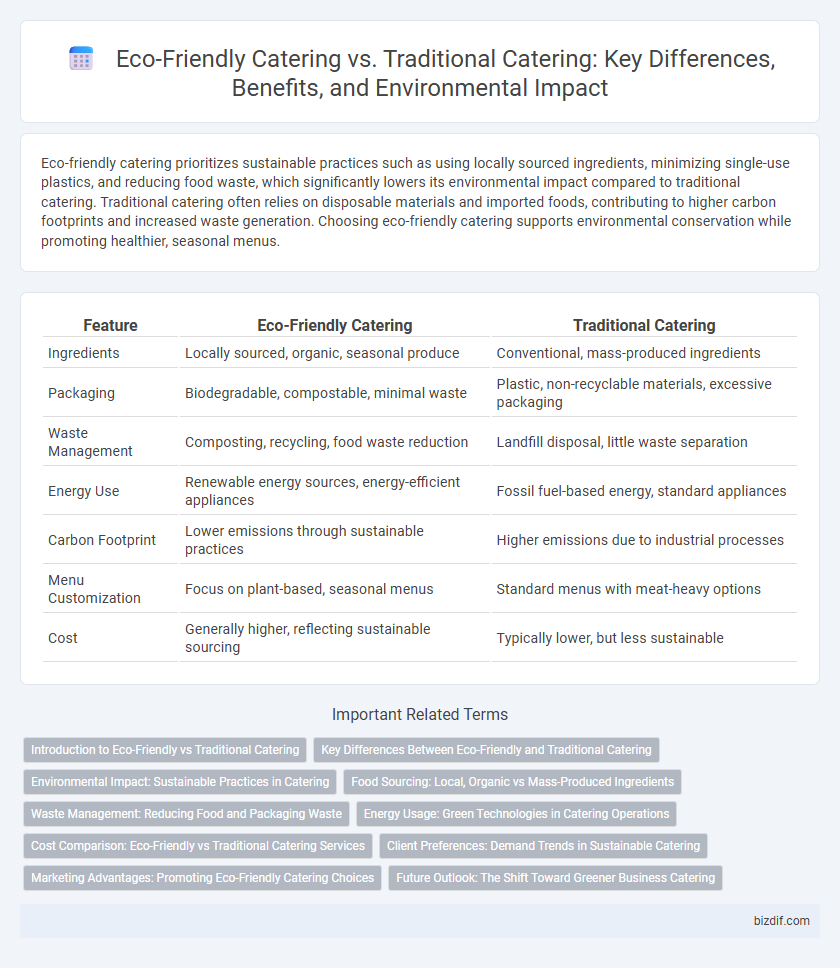Eco-friendly catering prioritizes sustainable practices such as using locally sourced ingredients, minimizing single-use plastics, and reducing food waste, which significantly lowers its environmental impact compared to traditional catering. Traditional catering often relies on disposable materials and imported foods, contributing to higher carbon footprints and increased waste generation. Choosing eco-friendly catering supports environmental conservation while promoting healthier, seasonal menus.
Table of Comparison
| Feature | Eco-Friendly Catering | Traditional Catering |
|---|---|---|
| Ingredients | Locally sourced, organic, seasonal produce | Conventional, mass-produced ingredients |
| Packaging | Biodegradable, compostable, minimal waste | Plastic, non-recyclable materials, excessive packaging |
| Waste Management | Composting, recycling, food waste reduction | Landfill disposal, little waste separation |
| Energy Use | Renewable energy sources, energy-efficient appliances | Fossil fuel-based energy, standard appliances |
| Carbon Footprint | Lower emissions through sustainable practices | Higher emissions due to industrial processes |
| Menu Customization | Focus on plant-based, seasonal menus | Standard menus with meat-heavy options |
| Cost | Generally higher, reflecting sustainable sourcing | Typically lower, but less sustainable |
Introduction to Eco-Friendly vs Traditional Catering
Eco-friendly catering emphasizes sustainable practices by utilizing locally sourced ingredients, biodegradable packaging, and minimizing food waste, reducing the environmental footprint compared to traditional catering. Traditional catering often relies on disposable plastic products, large-scale food production, and extensive transportation, contributing to higher carbon emissions and waste generation. Choosing eco-friendly catering supports conservation efforts, promotes organic food use, and aligns with growing consumer demand for environmentally responsible dining options.
Key Differences Between Eco-Friendly and Traditional Catering
Eco-friendly catering prioritizes sustainable practices such as using locally sourced organic ingredients, biodegradable packaging, and minimizing food waste, contrasting with traditional catering's reliance on conventional supply chains and single-use plastics. Eco-friendly services often implement energy-efficient cooking methods and emphasize plant-based menus, reducing carbon footprints compared to the typically meat-heavy and resource-intensive traditional menus. Waste management also differs significantly, with eco-friendly catering focusing on composting and recycling, whereas traditional catering commonly generates higher landfill waste.
Environmental Impact: Sustainable Practices in Catering
Eco-friendly catering significantly reduces environmental impact by utilizing biodegradable packaging, sourcing local and organic ingredients, and minimizing food waste through efficient portion control. Traditional catering often relies on single-use plastics, long-distance food transportation, and excessive energy consumption, contributing to higher carbon emissions and landfill waste. Sustainable practices in catering promote resource conservation, lower greenhouse gas emissions, and support biodiversity, aligning with global environmental goals.
Food Sourcing: Local, Organic vs Mass-Produced Ingredients
Eco-friendly catering prioritizes sourcing local and organic ingredients, reducing carbon footprints and supporting sustainable farming practices. Traditional catering often relies on mass-produced ingredients that may involve extensive transportation and synthetic pesticides. Choosing local, organic food enhances freshness and nutritional value while promoting environmental responsibility in event planning.
Waste Management: Reducing Food and Packaging Waste
Eco-friendly catering prioritizes sustainable waste management by minimizing food waste through precise portion control and donating surplus food to local shelters, contrasting with traditional catering's higher disposal rates. It employs biodegradable and compostable packaging materials, significantly reducing plastic waste and landfill contributions. These practices collectively lower the environmental impact and promote a circular economy within the catering industry.
Energy Usage: Green Technologies in Catering Operations
Eco-friendly catering significantly reduces energy consumption by integrating green technologies such as energy-efficient appliances, solar-powered equipment, and LED lighting, lowering operational carbon footprints compared to traditional catering. Implementing smart energy management systems optimizes resource usage, cutting down electricity costs while maintaining food safety and quality standards. Traditional catering often relies on outdated, energy-intensive equipment, resulting in higher greenhouse gas emissions and increased utility expenses.
Cost Comparison: Eco-Friendly vs Traditional Catering Services
Eco-friendly catering services often have higher upfront costs due to sourcing sustainable ingredients and using biodegradable materials, but they can reduce long-term expenses through minimized waste disposal fees and energy-efficient practices. Traditional catering generally incurs lower immediate costs by utilizing conventional packaging and bulk purchasing, yet it may lead to higher environmental and regulatory expenses over time. Analyzing total cost of ownership reveals eco-friendly options provide better value by aligning with increasing consumer demand for sustainability and potential tax incentives.
Client Preferences: Demand Trends in Sustainable Catering
Client preferences in catering increasingly favor eco-friendly options, reflecting a significant rise in demand for sustainable catering services. Consumers prioritize locally sourced, organic ingredients and biodegradable packaging, driving a shift away from traditional catering practices. Market data shows a growing percentage of event planners and corporate clients selecting environmentally conscious catering to align with green values and reduce carbon footprints.
Marketing Advantages: Promoting Eco-Friendly Catering Choices
Eco-friendly catering offers significant marketing advantages by appealing to environmentally conscious consumers seeking sustainable dining options. Highlighting the use of locally sourced, organic ingredients and biodegradable packaging enhances brand reputation and differentiates services in a competitive market. Emphasizing commitment to reducing carbon footprint and waste attracts clients who prioritize corporate social responsibility and sustainable event planning.
Future Outlook: The Shift Toward Greener Business Catering
Eco-friendly catering is rapidly becoming the preferred choice in corporate events due to increasing demand for sustainable practices and reduced environmental impact. Innovations in biodegradable packaging, locally sourced organic ingredients, and waste reduction technologies are driving significant growth in this sector. Green business catering is projected to dominate the market as companies adopt stricter sustainability goals to align with global climate initiatives and corporate social responsibility standards.
Eco-friendly catering vs traditional catering Infographic

 bizdif.com
bizdif.com